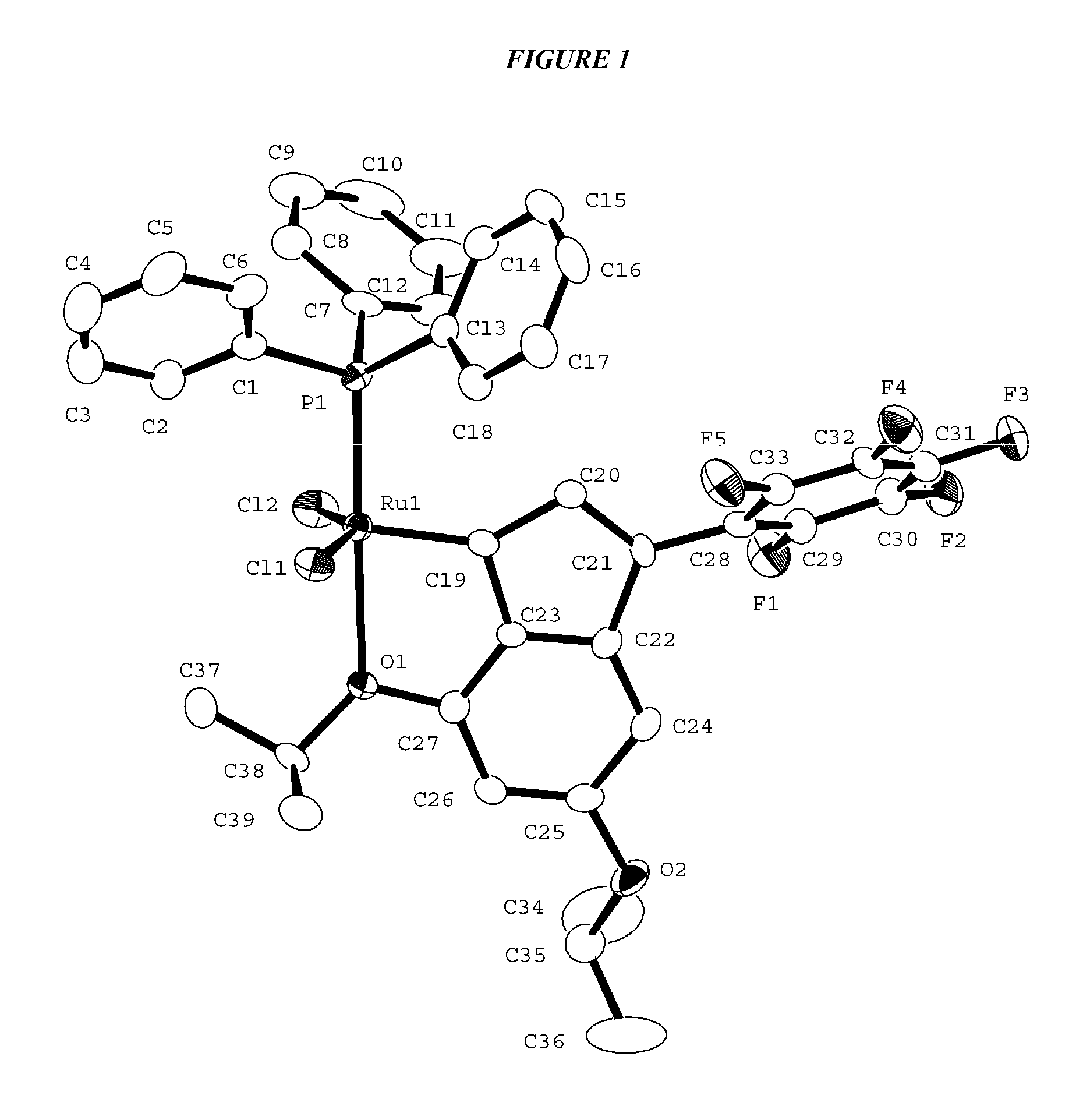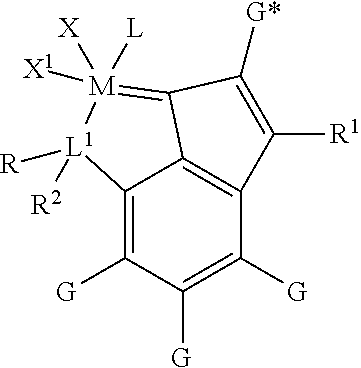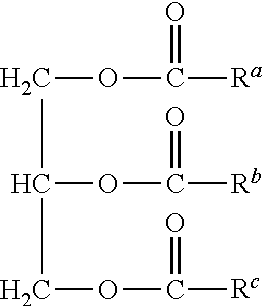Metathesis Catalyst and Process for Use Thereof
a technology of metal catalysts and catalysts, applied in the field of olefin metathesis, can solve the problems of heterogeneous catalysts, tungsten and rhenium oxides, and the inability to achieve the effect of internal olefins containing functional groups
- Summary
- Abstract
- Description
- Claims
- Application Information
AI Technical Summary
Benefits of technology
Problems solved by technology
Method used
Image
Examples
example 1
Synthesis of (PPh3)Cl2Ru(3-3,5-dimethoxyphenyl-6,8-dimethoxyinden-1-ylidene)
[0166]Bis(3,5-dimethoxyphenyl)methanol (A): 3,5-Dimethoxybenzaldehyde (5.0 g, 30 mmol) was dissolved in 150 mL THF in a 500 mL round bottom flask. 3,5-Dimethoxyphenyl magnesium chloride (1 M in THF, 45 mL) was added slowly. The reaction was heated at 40° C. for 4 hours then quenched with saturated ammonium chloride. The mixture was extracted with 3 portions of ether and the combined organic layers washed with brine, dried over anhydrous MgSO4, then concentrated to a crude pale yellow solid which was carried forward to the next step.: 1H NMR (250 MHz, C6D6): δ 3.29 (d, J=5.0 Hz, 12H), 6.46 (m, 2H), 6.56 (m, 1H), 6.76 (m, 2H), 7.04 (t, J=8.2 Hz, 1H).
[0167]Bis(3,5-dimethoxyphenyl)methanone (B): Pyridinium chlorochromate (PCC) (12.9 g, 30 mmol) was suspended in 30 mL dichloromethane in a 200 mL round bottom flask. Crude bis(3,5-dimethoxyphenyl)methanol from above (compound A) was suspended in 30 mL dichlorometha...
example 2
Synthesis of (PPh3)Cl2Ru(3-pentafluorophenyl-6,8-diisopropoxyinden-1-ylidene) (J)
[0171]Isopropyl 3,5-diisopropoxybenzoate (E): In a 1 L round bottom flask, 3,5-dihydroxybenzoic acid (10 g, 64 mmol), potassium carbonate (42 g, 260 mmol) and cesium carbonate (30 g, 92 mmol) were dissolved in 300 mL dimethylformamide. After stirring at ambient temperature for approximately 20 min, 2-iodopropane (43 g, 256 mmol) was added. The reaction was allowed to stir overnight, then quenched with water and extracted with three portions of ethyl acetate. The combined organic layers were washed twice with both water and brine, then dried (MgSO4), filtered and concentrated to a yellow oil: Rf 0.48 (30:70 acetone / hexane); IR (cm−1): 2978, 2935, 1715, 1593, 1449, 1372, 1296, 1234, 1183, 1112, 1038, 769; 1H NMR (250 MHz, C6D6): δ 1.07 (dd, J=6.7, 12.0 Hz, 18H), 4.20 (qn, J=6.2 Hz, 2H), 5.22 (qn, J=6.2 Hz, 1H), 6.75 (t, J=2.5 Hz, 1H), 7.56 (d, J=2.5 Hz, 2H); 13C NMR (63 MHz, C6D6): 23.7 (2C), 23.8 (4C), ...
example 3
Synthesis of (PCy3)Cl2Ru(3-pentafluorophenyl-6,8-diisopropoxyinden-1-ylidene) (K)
[0178](PCy3)Cl2Ru(3-pentafluorophenyl-6,8-diisopropoxyinden-1-ylidene) (K): A 10 mL vial was charged with (PPh3)Cl2Ru(3-pentafluorophenyl-6,8-diisopropoxyinden-1-ylidene) (compound J, 0.40 grams). Benzene (2 mLs) was then added followed by tricyclohexylphosphine (0.13 grams). The reaction was allowed to sit overnight. Excess Cu(I)Cl was added, approximately 0.50 grams. The resulting slurry was dried under vacuum, and pentane was used to extract the product (0.038 g) from the solids. The product was characterized by NMR spectra (1H, 13C, and 31P). The results are as below: 1H NMR (250 MHz, CD2Cl2, 30° C.): δ=7.35 (s, 1H), 6.64(s, 1H), 6.38 (s, 1H), 4.62 (sept, 1H), 4.26(sept, 1H), 1.72(d, 6H), 1.36(d, 6H), 1.5-2.4 (m, 33H); 19F NMR (250 MHz, CD2Cl2, 30° C.): δ=−137.34 (d, J=17.5 Hz, 2F), −154.4 (t, J=22.5 Hz, 1F), −161.6 (dt, J=6.5, 22.5 Hz, 2F); 31P NMR (250 MHz, CD2Cl2, 30° C.): δ=68 ppm.
PUM
| Property | Measurement | Unit |
|---|---|---|
| Fraction | aaaaa | aaaaa |
| Fraction | aaaaa | aaaaa |
| Mass | aaaaa | aaaaa |
Abstract
Description
Claims
Application Information
 Login to View More
Login to View More - R&D
- Intellectual Property
- Life Sciences
- Materials
- Tech Scout
- Unparalleled Data Quality
- Higher Quality Content
- 60% Fewer Hallucinations
Browse by: Latest US Patents, China's latest patents, Technical Efficacy Thesaurus, Application Domain, Technology Topic, Popular Technical Reports.
© 2025 PatSnap. All rights reserved.Legal|Privacy policy|Modern Slavery Act Transparency Statement|Sitemap|About US| Contact US: help@patsnap.com



